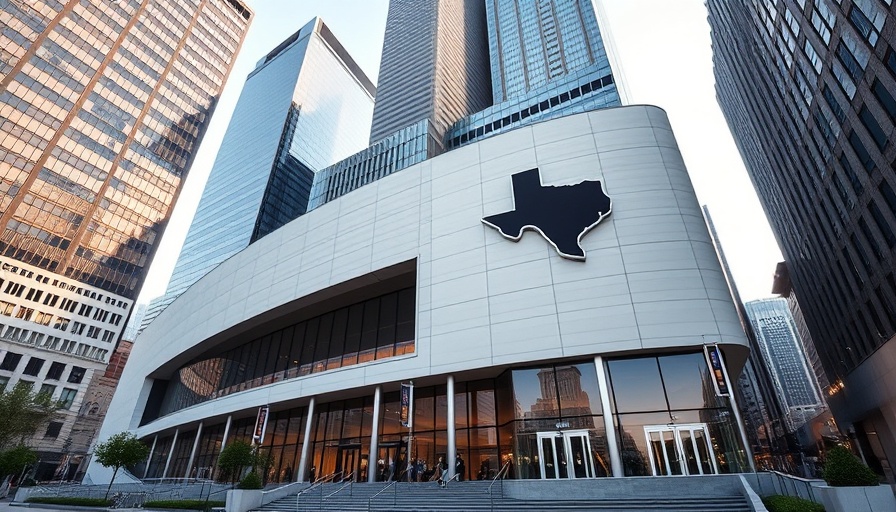
The Future of Dallas: A New Convention Center Proposal
The recent proposal from Hunt Realty to relocate the Kay Bailey Hutchison Convention Center near Reunion Tower has sparked significant dialogue among local leaders and transportation officials. Rooted in a broader $5 billion redevelopment plan for the vicinity, which includes residential spaces, offices, and retail areas, the initiative signals ambition for the city’s growth while raising questions about its implications on long-standing transportation projects like the high-speed rail aimed at connecting Dallas to Fort Worth.
What the Proposal Entails
Hunt Realty's ambitious vision involves shifting the convention center's location westward toward a city-owned parking lot. Renderings by the Amsterdam-based architecture firm WOMO propose creating elevated parks that would link the convention center, new affordable housing, and Reunion Tower, thus enhancing local accessibility and green space. While the designs promise to revitalize the area, they also invoke serious concerns from regional transportation planners.
Transportation Concerns: A Red Flag?
Local officials have raised alarms regarding potential conflicts with existing infrastructure plans, particularly the high-speed rail project that has been in the pipeline for years. Michael Morris, a key figure in transportation planning within the North Central Texas Council of Governments, articulated worries that the convention center's proposed shift could derail coordinated efforts already established with major transportation initiatives, such as DART and freight rail systems. Morris asserted, "Years of work have already been conducted to ensure compatibility with Interstate Highway 30 and high-speed rail initiatives. The proposed project might contravene that work." This highlights a clash of priorities—urban redevelopment versus transportation efficiency.
City Leaders Weigh Options
Dallas City Manager Kimberly Bizor Tolbert has emphasized the importance of these projects, acknowledging that while structural design efforts are ongoing for the convention center, no final decisions have been reached. Council members are still exploring all options, balancing the need for a modern convention center against the potential impacts of relocating key facilities. For example, distancing the convention center from the Omni Hotel raises practical concerns about event hosting and accessibility.
Broader Implications for Dallas Businesses
The debate surrounding this proposal showcases a larger narrative unfolding within Dallas’ business landscape. Local businesses and entrepreneurs are attuned to these developments as they could reshape the city's economic landscape. The revitalization project aims to boost tourism and conventions, vital lifelines for many Dallas businesses, especially in the hospitality sector. Plans for the convention center, including nearly tripling its meeting space and double the ballroom area, could increase business opportunities for local vendors but also require careful consideration of surrounding infrastructures to avoid choke points during major events.
The Return on Investment
As Dallas businesses stake their futures on the success of such ambitious projects, the anticipated economic return cannot be overlooked. Successful implementation of the new convention center is projected to spur significant economic activity, estimated in the billions. Proponents argue that enhancing convention spaces and integrating them with shopping, housing, and entertainment will attract more visitors, translating into increased revenue for local businesses. This entails not just financial gains but the creation of jobs in the hospitality and construction sectors, offering a boost to Dallas’ economy.
Community Engagement and Long-term Success
As this vision for the convention center unfolds, it's crucial for Dallas leaders to engage with the community at every step. Success hinges on understanding community needs, securing public buy-in, and ensuring that developments enhance, rather than detract from, the quality of life in Dallas. Regular updates and forums would ensure that local voices are heard as plans progress, emphasizing transparency in what will ultimately shape the future of a key area in the city.
Conclusion: What Lies Ahead
While discussions continue regarding Hunt Realty's proposal, the overarching narrative showcases Dallas as a city willing to innovate and grow. Balancing redevelopment ambitions and transportation infrastructures shapes the future of its urban landscape. Stakeholders from various facets of the city are being called upon to come together, ensuring that Dallas not only expands but does so in a coordinated, sustainable manner that supports long-term prosperity for Dallas's businesses and residents alike.
 Add Element
Add Element  Add Row
Add Row 



Write A Comment